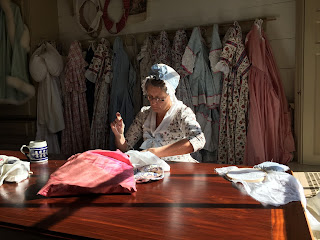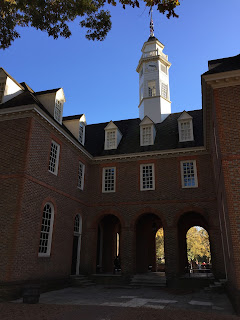Location: 310 S England St, Williamsburg, VA 23185
Phone: (800) 228-8878
Website: www.colonialwilliamsburg.com
Hours: 8:45 a.m. – 5:00 p.m.
Ticket Price: Adult: $40.99, Youth: $20.49
Homeschool discount? No, but Homeschool Days are usually held in September
We Visited: Saturday, November 12, 2016
Colonial Williamsburg is set up to represent Virginia in the
18th century (1700’s). Williamsburg served as the capital of
Virginia during that time (beginning in 1698 – when it was known as Middle
Plantation – the name was changed to Williamsburg to honor King William III in
1699).
It’s filled with over 50 sites, trades, taverns, and shops
from that period. Many costumed interpreters fill the streets and buildings and
add a theatrical touch. They speak about events that occurred there during the
18th century as well as other events that were shaping the new world
(ie: the Boston Tea Party). They also reenact many events that took place
there, allowing visitors to become a part of the historical event.
We entered through the Visitor’s Center, bought tickets, and were given a map and daily schedule. From there, visitors can take the free
(included with a paid ticket) shuttle to a stop near different attractions
within the historic area, or they can walk over to the historic town. We exited
the back of the Visitor’s Center and walked the path to the main area. Along
the way, you’ll cross a bridge that treats you to major events that happened
between the present day and the late 1700’s. They appear in reverse order, so
as you cross the bridge, you’re walking back in time.
As you walk the path, the first thing you come to is a separate area known as Great Hopes Plantation. It’s only open Tuesday and Thursday – Saturday, but it’s a treat that gives you an idea of what life would be like outside the main city. About 90% of the colonial population lived and worked in rural, agricultural places such as this.
The area is a working farm consisting of two gardens, crop fields, a slave house, corn house, smokehouse, kitchen, and tobacco house. A Planter’s house is proposed but has not yet been built. Costumed interpreters are available throughout the plantation to discuss how their lived would have been back in the 18th century.
We visited several shops, all staffed by interpreters in
period attire. Most interesting to us was the Milliner and Mantua Maker shop
which was filled with several ladies working on clothing from that time. One
woman was busy embroidering linen, which was used for most clothing then.
The
interpreter answered many questions from the visitors, including how pregnant
ladies dressed during that time, questions about undergarments (they weren’t
considered taboo at that time – a pregnant lady could feel free to walk down
the main street in an unlaced corset in her third trimester if that was how she
was most comfortable - and no one would have given it a second thought! Also, the interpreters pointed out that women worked just as hard as man during the
colonial period.
As we strolled through the streets, we noticed horse-drawn carriages throughout the day. They are available for tours (not included in the ticket).
We walked to the Indian Camp area for the next program –
History of a People.
There, a Cherokee man told us three different stories from
the Cherokee. He was originally from Cherokee, NC, and said that there wouldn’t
have normally been Cherokee in that area of Virginia – those were Powhatan
Indians. But, it was interesting to hear the Cherokee stories about the earth’s
creation as well as other things, and also hear how the stories had been passed
down from generation to generation (Native Americans did not have a written
language).
We stopped into the Courthouse, where visitors can
participate in a court session and see 18th century justice in
action.
We visited in between sessions, but were greeted by a costumed interpreter who told us all about the Courthouse as well as gave us a tour.
We ate lunch at Chowning’s Tavern that included Brunswick Stew, patsies, hot buttered rum, and apple pie. Everything was simply delicious and very filling! It was a bit on the pricey side, but well worth it, for both the experience and the tasty lunch. Be sure to get your name on the list early - the wait list is long, especially on busier days.
The wait staff wore period clothing, and costumed musicians entertained us as we dined.
We then toured the Governor’s Palace – the grand home of
Governor Dunmore before the collapse of the royal government in Virginia.
The
maze out back was a lot of fun - be sure to check it out! Also, I'm sure the gardens are lovely when they're in bloom.
We then toured the church (not completely part of Colonial
Williamsburg) before touring the Capitol building (downstairs and upstairs).
We also visited the Gaol (jail) which once held the pirate Blackbeard’s crew.
We then took the shuttle back to the Visitor’s Center. It was odd that the
shuttle circled the entire area, and returned to our original stop before going
back to the Visitor’s Center. The map does not have a shuttle stop symbol on
the Visitor Center, so we first feared that it didn’t actually go back to the
Visitor’s Center and we were riding in vain. The Colonial Williamsburg app
didn’t have the shuttle routes built into it, either.
We didn’t stay for the evening events - all but one required an additional ticket purchase. The ghost tours (these may be seasonal?) sounded very
interesting, though, and may be worth revisiting.
Colonial Williamsburg felt as much like a theme park as it
did an historical site. While it was fun to visit, and we learned a good deal
about daily life in the 1700’s, we missed having some sort of walk through sequence of
historical events – some sort of timeline to help bring it all together and fit
it into history. Also, it’s worth going multiple days in order to see more
attractions. We were only able to scratch the surface during our one-day visit.
Many of the shops and attractions are only open certain days, so visiting more
than once would be beneficial.
It was fun, but very expensive, and more like a history theme
park than an historical site. It's owned and run by the Colonial Williamsburg
Foundation.
Tip: Before you go, download the free Colonial Williamsburg
Explorer mobile app for easy access to the map, interactive event information, and fun
stuff like photo frames.




























No comments:
Post a Comment